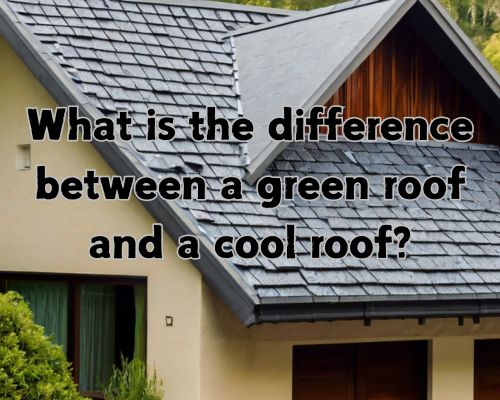What is the Difference Between a Green Roof and a Cool Roof?

Key Benefits and Features Explained
When considering sustainable options for your roof, you might be weighing the benefits of a green roof versus a cool roof.
Based on Star Roofing Contractors, a green roof is essentially a rooftop garden, comprised of a vegetative layer that reduces surface and surrounding air temperatures. These roofs provide the added benefits of shade and removal of heat from the air, making them particularly effective in urban areas.

On the other hand, a cool roof uses materials designed to reflect more sunlight and absorb less heat. This type of roof stays cooler by having a high solar reflectance and also effectively releasing absorbed heat through infrared radiation.
Cool roofs can significantly lower the temperature of your building, much like how wearing light-colored clothing keeps you cooler on sunny days.
Your choice between a green roof and a cool roof will largely depend on your specific needs and environmental goals. While green roofs offer aesthetic and ecological benefits, cool roofs excel in immediate heat reduction and energy efficiency.
Each option has its unique advantages, making it essential to consider factors such as installation costs, maintenance, and desired outcomes for energy savings and environmental contribution.
Understanding Green Roofs and Cool Roofs
Green roofs and cool roofs offer significant advantages in terms of energy efficiency, cost-effectiveness, and environmental impact. With Star Roofing Contractors, you will explore the definitions, types, core advantages and disadvantages, and the climate impact of these roofing options.
Definition and Types
Green Roofs are covered with vegetation and consist of layers that may include a waterproof membrane, drainage layers, and soil. They come in two main types:
- Extensive Green Roofs: Lightweight, minimal soil depth, and low maintenance. Often used for smaller plants like sedums.
- Intensive Green Roofs: Heavier, deeper soil layers, supporting a wider variety of plants including shrubs and small trees. Requires more maintenance.
Cool Roofs reflect more sunlight and absorb less heat than traditional dark roofs. They commonly employ:
- Single-Ply Membranes: Reflective and durable. Used on flat or low-sloped roofs.
- Built-Up Roofs: Multiple layers including reflectivity-enhancing coatings.
Core Advantages and Disadvantages
Green Roofs:
- Advantages
- Energy savings through natural insulation.
- Reduces urban heat island effect.
- Enhances air quality through CO2 absorption and oxygen production.
- Increases roof life through membrane protection.
- Disadvantages
- Higher initial cost and structural support requirements.
- Maintenance can be intensive, particularly for intensive green roofs.
Cool Roofs:
- Advantages
- Lower installation and maintenance costs.
- Significant reduction in cooling energy usage.
- Easily adaptable to various roofing materials.
- Disadvantages
- Limited aesthetic value compared to green roofs.
- May not provide as significant benefits for urban heat island reduction.
Climate and Environmental Impact
Green Roofs contribute to:
- Reducing Urban Heat Islands: Vegetation cools the surrounding air through evapotranspiration.
- Carbon Footprint Reduction: By absorbing CO2 and other pollutants.
- Improved Air Quality: Filtration of air pollutants and greenhouse gases.
Cool Roofs are effective in:
- Lowering Urban Heat Island Effects: By reflecting solar radiation.
- Reducing Energy Consumption: Less heat absorption leads to lower cooling demand.
- Minimizing Greenhouse Gas Emissions: Lower energy requirements reduce emissions from power plants.
Comparative Analysis of Benefits and Limitations
Green roofs and cool roofs offer distinctive advantages and challenges, particularly in terms of energy efficiency, roofing materials, and cost. Each roofing system has its unique characteristics that make it suitable for specific applications.
Energy Impact and Insulation Properties
Green roofs provide excellent thermal insulation due to layers of vegetation, soil, and additional roofing systems. This insulation helps in reducing energy use for air conditioning in commercial and residential buildings. Plants on green roofs contribute to evapotranspiration, cooling the rooftop surface.
Conversely, cool roofs utilize reflective coatings or membranes to maximize solar reflectance and thermal emittance. This results in significant reduction of roof surface temperatures and energy costs. Cool roofs are particularly effective in low-sloped and sloped architectures, reflecting most incident solar radiation.
Roofing Materials and Technologies
Green roofs include vegetation layers, soil, and sometimes water retention systems. These elements offer aesthetic and environmental benefits, such as air quality improvement and noise reduction. However, it is crucial to ensure proper drainage and waterproofing to avoid structural issues.
Cool roofs are composed of reflective shingles, roof coatings, and reflective membranes. The choice of material depends on the building’s requirements and Cool Roof Rating Council standards. The reflective nature of these materials minimizes heat absorption, making them ideal for urban areas.
Cost and Economic Incentives
Green roofs have higher installation costs, ranging from **$15-$20 per square foot**. Additional costs include potential roof reinforcement and ongoing maintenance.
Despite the higher initial investment, green roofs can offer economic incentives such as energy savings and potential rebates.
Cool roofs generally have lower installation costs compared to green roofs. The use of roof coatings like cool white coatings can have an average cost that is substantially lower.
Cool roofs also qualify for various economic incentives and rebates aimed at promoting energy efficiency. These can help offset the initial installation and maintenance costs.
Understanding the differences between green and cool roofs is crucial for making an informed decision that best suits your building’s needs, whether commercial or residential.
Each offers unique benefits, and your choice can significantly impact your energy bills and environmental footprint.

